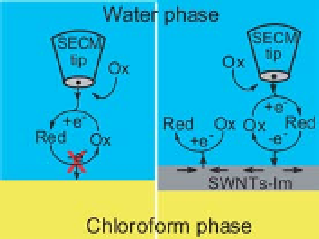Biomedical Engineering Reference
In-Depth Information
sorts of synthetic challenges. We have illustrated this flexibility of
ILs by selecting SWNT (R1) as a model substituting group of the
imidazolium cation, and Br
, polyoxometalates (POMs),
and even glucose oxidase (GOD) as the counter-anions (Fig. 4.14a,
SWNT-IL-X) [56]. The properties of SWNT and the various anions
were facilely and successfully delivered into the resulting compounds.
For example, the rich redox activity was also successfully transferred
into SWNT-IL-POM merely by a simple and facile anions exchange.
The surface-confined SWNT-IL-POM shows three couples of well-
defined redox waves at scan rates up to 2 V/s (Fig. 4.14b), which
was presumably attributed from electron conduction of SWNT, ionic
conduction of IL, and redox conduction of POM. It was unusual for an
often-seen compound in electrochemical systems.
-
, PF
-
, BF
-
6
4
(a)
(b)
Figure 4.15
(a) SECM arrangement (not to scale) for feedback measurement
at pure (left) and SWNTs-Im-sandwiched (right) water/chloroform interface;
(b) Experimental approach curves (CHI 900) for a tip in aqueous solution
approaching SWNTs-Im-sandwiched (I) and pure (II) water/chloroform
interface. Currents are normalized to the steady-state diffusion limiting
current,
i
and distance to tip radius. The aqueous solution contained 0.5
T,∞
mM Ru(NH
)
3+
and 100 mM KCl. The tip (Pt, 10
m
m radius, RG = 10) was
3
6
held at
-
0.35 V vs. Ag|AgCl (saturated KCl) for Ru(NH
)
3+
reduction and
3
6
m
approached at 1
m/s. The counter electrode was Pt wire [58]. Reproduced
by permission of The Royal Society of Chemistry.
Moreover, due to the controllable wettability by counter-
anion exchange [56, 57], SWNT-IL-Br, which was both hydrophobic
and hydrophilic, could assemble at the water/oil interface in a
controllable manner, i.e., from monolayer to multilayers [58]. Thus,
it enabled a novel SWNT-sandwiched water/oil interface for the










Search WWH ::

Custom Search